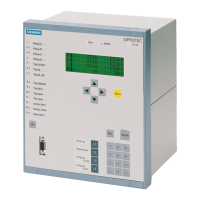Functions
2.6 Direct Local Trip
SIPROTEC, 7SD610, Manual
C53000-G1176-C145-6, Release date 02.2011
90
2.6 Direct Local Trip
Any signal from an external protection or monitoring device can be coupled into the signal processing of the
7SD610 by means of a binary input. This signal can be delayed, alarmed and routed to one or several output
relays.
2.6.1 Method of Operation
External trip of the local circuit breaker
Figure 2-35 shows the logic diagram. If device and circuit breaker are capable of single-phase operation, it is
also possible to trip single-pole. The tripping logic of the device ensures that the conditions for single-pole trip-
ping are met (e.g. single-phase tripping permissible, automatic reclosure ready).
The external tripping can be switched on and off with a setting parameter and may be blocked via binary input.
Figure 2-35 Logic diagram of the local external tripping
2.6.2 Setting Notes
General
A prerequisite for the application of the direct and remote tripping functions is that during the configuration of
the scope of functions in address 122 DTT Direct Trip = Enabled was applied. At address 2201 FCT
Direct Trip it can also be switched ON or OFF.
For the external local trip, a trip time delay can be set in address 2202 Trip Time DELAY. This delay time
can be used as security time margin.
Once a trip command has been issued, it is maintained for at least as long as the set minimum trip command
duration TMin TRIP CMD which was set for the device in general in address 240 (Section 2.1.2). Reliable
operation of the circuit breaker is therefore ensured, even if the initiating signal pulse is very short. This param-
eter can only be altered in DIGSI at Additional Settings.
